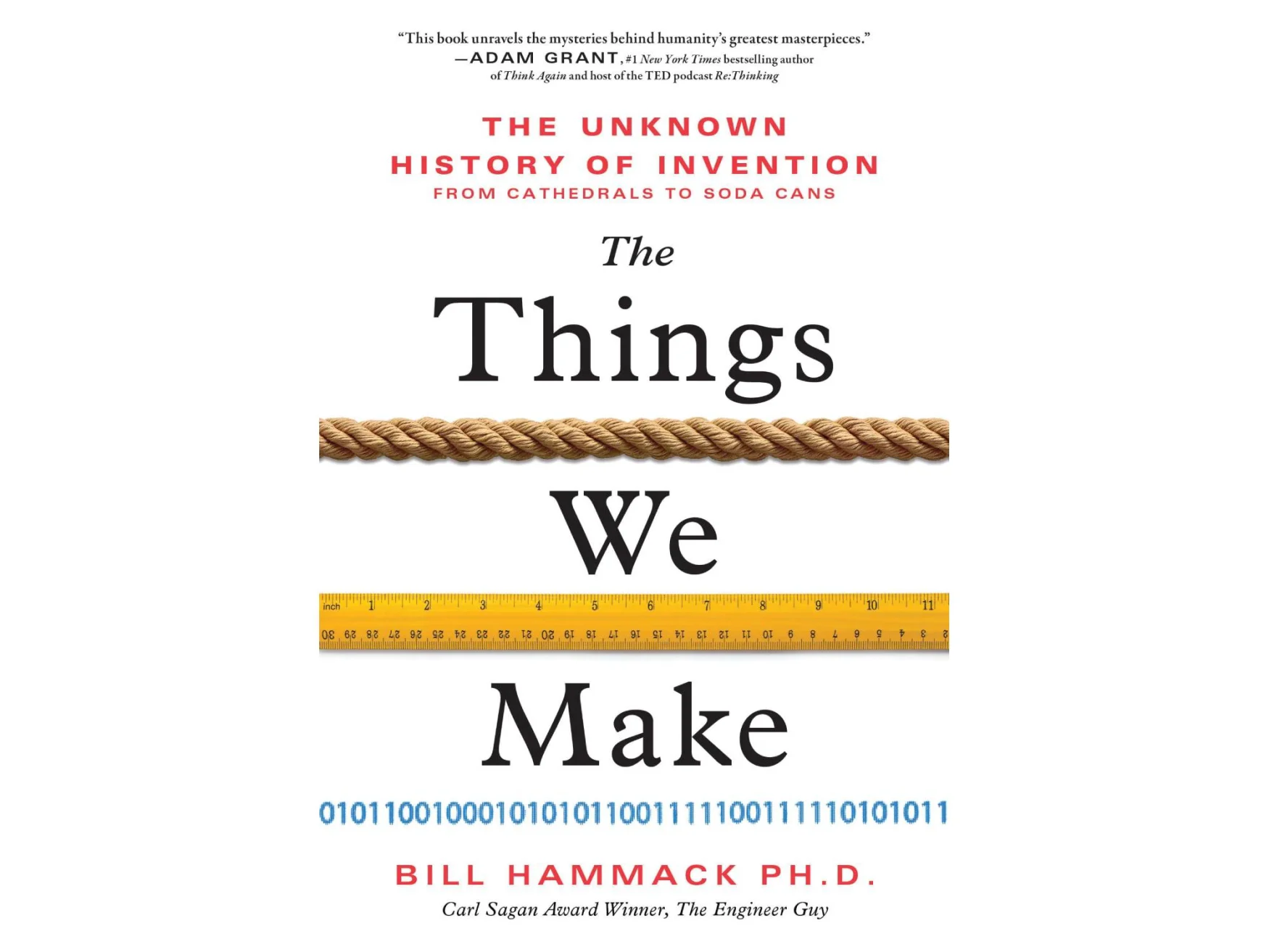One element that is typically omitted from fashionable founders myths is whether or not or not stated scion of capitalist success really invented the factor they’re well-known for inventing. Similar to Elon Musk did not invent electrical automobiles a lot as be the primary to efficiently market them to the American public, Thomas Edison’s contributions to the appearance of electrified lighting too may be overstated. Within the excerpt under from his newest e book, The Things We Make: The Unknown History of Invention from Cathedrals to Soda Cans, Dr. Invoice Hammack, YouTube’s “The Engineer Man,” recounts the story of Hiram Maxim, an irrepressible engineer and inventor whose novel filament manufacturing methodology would have made him a family identify — had Edison not reportedly made “a clear steal” of his revolutionary expertise.

Sourcebooks Inc
Excerpted from The Things We Make: The Unknown History of Invention from Cathedrals to Soda Cans by Invoice Hammack, PhD. © 2023 by Invoice Hammack, PhD. Used with permission of the writer, Sourcebooks, Inc. All rights reserved.
In November 1880, the studying room of the Mercantile Protected Deposit Firm, situated within the basement of one of many first skyscrapers, glowed with the sunshine of a four-bulb chandelier and 6 bulbs in fixtures spaced alongside the partitions. An observer characterised this electrical mild as “very very similar to that of a first-class oil lamp, steadier than fuel, and of a yellow, clear nice high quality” — nothing just like the “ghastly blue” of a “flickering” arc mild, nor was there the odor of burning fuel; as a substitute, the room’s environment “stay[ed] completely cool and candy.” His solely criticism was that the bulbs flickered barely with each stroke of the engine that powered the generator. This primary business set up, a spectacular achievement, featured no bulbs manufactured by Thomas Edison, though he had proudly introduced his invention of the sunshine bulb just a few months earlier to nice press consideration. The bulbs on the Mercantile Firm have been these of the U.S. Electrical Lighting Firm, an organization pushed ahead by their irrepressible and energetic engineer, Hiram Maxim. Edison known as Maxim’s bulb “a clear steal” of his lamp. But Maxim had seventeen patents on incandescent lamps, and his firm managed the patents of a number of different inventors, additionally up to date to Edison. Maxim considered himself because the inventor of the business mild bulb. “Each time I put up a light-weight,” he complained, “a crowd would collect, everybody asking, ‘Is it Edison’s?’” This so irritated Maxim, who famous that Edison on the time “had by no means made a lamp,” that he contemplating killing “on the spot” the following individual to ask him “Is it Edison’s?”
That the primary commercialized mild bulbs weren’t Edison’s surprises as a result of we love tales of sole inventors whose spark of inspiration revolutionized the world. They offer us narratives which might be neat, tidy, and digestible however incomplete. These tales disguise the engineering methodology; they bury the creativity of engineers, easy over struggles, and sanitize selections that mirror cultural norms. Maybe no story persists greater than Edison and his mild bulb, but Edison was the tail finish of a protracted listing of sunshine bulb innovators in a means of invention much like that of the steam turbine within the subsequent century.
Within the forty years earlier than Edison’s first profitable prototype, at the least twenty individuals offered, patented, and demonstrated incandescent lamps—utilizing electrical energy to warmth a filament till it glowed. The primary recorded try was in 1838 (nearly a decade earlier than Edison’s delivery) by a Belgian inventor whose bulb used a strip of carbon as a filament. A good evaluation of historical past would name these males inventors of the sunshine bulb similar to Edison, particularly in a world the place Edison, the so-called inventor of the incandescent mild bulb, was forty years late to the thought of incandescent lighting. However not like with Edison, we don’t keep in mind the names of those males, as a result of most of their bulbs burned for just a few seconds. That they had the mandatory however thankless job of making hyperlinks in a sequence of incremental advances that didn’t but produce an relevant or reproducible resolution to the issue of darkness, which to date might solely be dispelled with fireplace, till Edison created one of many hyperlinks that did, reworking from methodology into narrative. Though Edison and his bulb finish that size of the chain of innovators, his hyperlink was no extra an train or instance of the engineering methodology than people who got here earlier than; it solely overcame a circumstantial threshold of usefulness.
In 1878, Edison targeted the power of his workers on the bustling Menlo Park Analysis Laboratory on discovering a long-lasting filament for the incandescent mild bulb. The workers labored to the rhythms of Edison, “the central originating and guiding thoughts and persona,” as one employee famous, describing work there as “a strenuous however joyful life for all bodily, mentally, and emotionally.” Edison set the tone with lengthy work hours into the evening. He typically napped on the workbenches in Menlo Park and ate sparingly in increments of small snacks he thought have been higher for digestion, though for his staff, he had introduced in, typically at midnight, hamper baskets loaded with sizzling dinners of meat, greens, dessert, and occasional. However when Edison stood, stretched, hitched up his waistband, and sauntered away, all knew that dinner was over and work ought to resume.
Within the late 1870s, Edison and his workers produced bulbs that appeared very similar to a contemporary bulb: a glass envelope fixed to a wood base lined with copper strips, and, at its middle, a skinny, lengthy, delicate spiral of platinum. But these bulbs failed. Some yielded mild as shiny as a small bundle of immediately’s Christmas lights for a couple of hours, however most burned out rapidly. As Edison discovered, the temperature for the incandescence of platinum wire was close to that of its melting level—any fluctuations within the present and the platinum would soften. Edison and his workforce examined an astonishing array of supplies, by some rely sixteen hundred varieties. They examined metals like platinum, iridium, ruthenium, chromium, aluminum, tungsten, molybdenum, palladium, manganese, and titanium; components that generally behaved like metals, together with silicon and boron; then a seize bag of supplies—cork, wax, celluloid, and the hair from his workers’ beards. After these, his workforce moved to slivers of wooden, broom corn, and paper. Tissue paper lined with lampblack and tar and rolled right into a rod glowed astonishingly nicely and for a superb period of time. Edison refined this concept by “carbonizing” cotton thread, heating it with out oxygen till the size of thread was blackened all through. From this thread, he shaped a protracted filament. On October 21, 1879, a bulb with a filament of this thread, with all of the air faraway from the glass enclosure, burned for greater than half a day. They have been approaching the start of the business mild bulb.
Seven months after that little bit of carbonized thread confirmed promise, they tried a chunk of bamboo: a six-inch strip burned for 3 hours and twenty-four minutes at seventy-one candlepower (concerning the brightness of a normal sixty-watt bulb immediately). “The perfect lamp ever but made,” an Edison affiliate famous, “right here from vegetable Carbon.” From there, Edison’s workforce examined 200 species of bamboo till they discovered a range that was the perfect for manufacturing carbon filaments, grown close to Yawata, Japan, the place Edison remains to be celebrated with a road named “Edison-dori,” a bust of Edison within the city middle, and, close to a shrine, a big monument devoted to Edison. Along with his specialised bamboo provide and methodology of producing in place, Edison was able to mild the world, however Hiram Maxim beat him out of the gate.
Maxim’s bulbs, put in on the Equitable Life Constructing, out-classed Edison’s. “They’ve a wealthy golden tint, resembling that of a wax taper,” stated one reporter. One other famous that Maxim “has invented a lamp which surpasses, I consider, even Edison’s goals.” When evaluating the lamps, reporters famous that Edison’s had decrease brightness than Maxim’s, or, when of the identical depth as Maxim’s, they burned out in just a few hours. By Maxim’s personal estimate, the filaments in his bulbs might final forty days. The dimness and shorter lifetime of Edison’s bulbs have been the identical factor: Edison’s bulbs couldn’t tolerate as a lot present as Maxim’s, so if run on the similar present, Edison’s bulbs would burn out rapidly, and to make them last more, Edison’s have been run at a decrease present and thus have been dimmer.
That Maxim might obtain this was unbelievable to Edison’s workers—an outraged member of the Menlo Park workers ranted that it have to be obvious to “any sane individual that” Maxim’s bulb have to be “however a duplicate” of Edison’s. Absolutely, thought Edison’s workers, solely a well-oiled machine like that of Menlo Park might produce a light-weight bulb. Inside Menlo Park, glassblowers, machinists, engineers, chemists, and physicists churned out innovations like home equipment on an meeting line, whereas Maxim’s ham-handed U.S. Electrical Lighting Firm struggled to seek out sufficient sources to outlive; workers thought it more likely to shut at any minute, and even its personal president described it as “helpless.” Their technical experience was so low that they might not determine, as one worker later famous, what “dimension wire would carry a sure variety of lamps with out overheating,” including that “a variety of mysterious fires about this time have been in all probability the fruits of our ignorance.” In contrast with Edison’s factory-line Menlo Park mannequin, Maxim’s methodology of invention appeared scattershot.
Maxim was the traditional American tinkerer, as soon as describing himself as a “continual inventor.” Though self-taught—one biographer describes him as “semiliterate”—over his lifetime, he invented an astonishing array of instruments and toys. Maxim developed strategies to separate metals from their ores, devices to measure wind velocities, vacuum cleaners, novelty gadgets that produced “illusionary results”—a rotating sphere with concave paraboloidal flooring, mirrors, and a bicycle observe, presumably to create the phantasm of driving a motorcycle lengthy distances—gear to stop the rolling of ships, riveting machines, feed water verify valves, steam mills, wheels for railroads and tramways, an inhaler to deal with bronchitis, boot and shoe heel protectors, hair curling irons, a technique for demagnetizing watches, a sort of pneumatic tire, a espresso substitute, a technique for extinguishing fires in theaters, and most stunning of all, new promoting strategies—a rotating signal that works “even in very mild airs.” And close to the tip of his life, he invented the world’s first profitable machine gun.
Maxim’s contribution to the sunshine bulb was to enhance the manufacture of filaments. Filaments, whether or not of bamboo or cardboard, as in Maxim’s case, have been transformed to carbon by heating at excessive temperatures within the absence of oxygen till the cellulose within the materials broke down, leaving a tough carbon skeleton, however uneven carbonization brought about thinner sections to turn out to be a lot hotter when lit with {an electrical} present and burn out extra rapidly. Maxim’s perception was to position a carbonized filament right into a hydrocarbon environment, then move by means of it {an electrical} present that heated the filament to a shiny purple. The thinner and warmer elements of the filament would break down the vaporous hydrocarbon surrounding them and deposit pure carbon on the filament, increase layers of carbon on the thinner elements and leading to a filament of uniform thickness and larger life span. As Maxim gloated, “it’s completely inconceivable by mechanical means to make a carbon filament that’s of uniform resistance” with out his patented methodology, including that Edison “had to make use of my course of or surrender the job.”
Maxim’s angle was prompted by the rivalry that burned between the numerous engineers competing in a world looking forward to the magic {of electrical} lighting, nevertheless it additionally reveals us the issue with crediting any particular person with the whole “invention” of any expertise. We have a tendency to inform the tales of inventors who, by means of their distinctive mind and drive, produce an equally distinctive marvel on the climax of a narrative with a starting, center, and finish. That’s typically how this e book has advised it, out of deference to particular person people’ have to relate to the tales of different particular person people. However the engineering methodology is uninterested on this “nice males” historic framework. It cares solely concerning the amassed data, heuristics, guidelines of thumb, instinct, and the rest that drives issues within the route of options as quick as attainable, the sum of which, even for a single resolution, is past unthinkable for a lone individual to create themselves. This net of knowledge is so huge, incomprehensibly huge, so we make it understandable and shifting by telling the tales of particular person inventors, even when this distorts the unknowable true net of invention.
Maxim is probably going unrecognized as an inventor immediately as a result of he lacked Edison’s agile self-promotion and since, in a way, Edison “received” and thus advised the story of the sunshine bulb’s invention. However did Edison “invent” a light-weight bulb when his firm produced a brilliantly glowing however short-lived electrical mild? Maybe. Once we consider an invented expertise, we usually indicate expertise that not solely exists however is reproducible in a approach that may fulfill the wants of these whose drawback it solves. That’s, it may be manufactured or mass-produced. A handful of working mild bulbs within the late 1800s is a marvel, nevertheless it doesn’t mild the world. On this sense, the invention of the sunshine bulb was a decades-long means of incremental modifications to create a filament that may be manufactured reliably and prolonged past Edison and Maxim alone. To inform solely a “nice man” story hides the contributions of others who have been important to a expertise’s growth. We will see that within the evolution of the manufacturing strategies of Maxim’s mild bulbs: he had on workers an inventive draftsman turned engineer whose contributions to dependable manufacturing have lengthy been neglected.
All merchandise really helpful by Engadget are chosen by our editorial workforce, unbiased of our dad or mum firm. A few of our tales embody affiliate hyperlinks. If you happen to purchase one thing by means of one in every of these hyperlinks, we could earn an affiliate fee. All costs are right on the time of publishing.
Trending Merchandise

Cooler Master MasterBox Q300L Micro-ATX Tower with Magnetic Design Dust Filter, Transparent Acrylic Side Panel…

ASUS TUF Gaming GT301 ZAKU II Edition ATX mid-Tower Compact case with Tempered Glass Side Panel, Honeycomb Front Panel…

ASUS TUF Gaming GT501 Mid-Tower Computer Case for up to EATX Motherboards with USB 3.0 Front Panel Cases GT501/GRY/WITH…

be quiet! Pure Base 500DX Black, Mid Tower ATX case, ARGB, 3 pre-installed Pure Wings 2, BGW37, tempered glass window

ASUS ROG Strix Helios GX601 White Edition RGB Mid-Tower Computer Case for ATX/EATX Motherboards with tempered glass…










